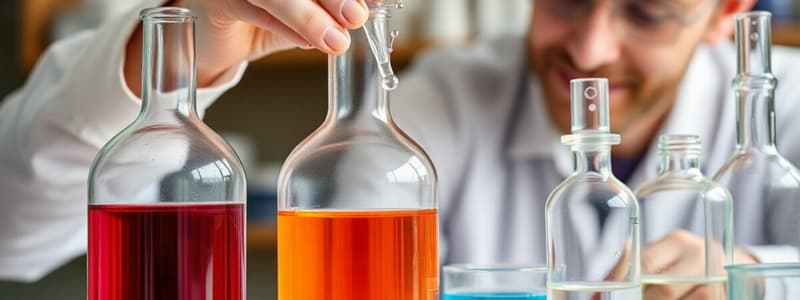Podcast
Questions and Answers
What type of flame is optimal for general heating and why?
What type of flame is optimal for general heating and why?
A non-luminous oxidizing flame is optimal because it provides maximum heat due to complete combustion of hydrocarbons.
Why is it important to rotate a glass tube while heating it?
Why is it important to rotate a glass tube while heating it?
Rotating the tube ensures uniform heating from all sides, preventing folds at the bend.
Define crystallization and its purpose.
Define crystallization and its purpose.
Crystallization is the conversion of a substance into a well-defined geometric shape, done to prepare a substance in the state of highest purity.
What is solubility, and how is it measured?
What is solubility, and how is it measured?
Explain the term 'water of crystallization'.
Explain the term 'water of crystallization'.
What is a saturated solution?
What is a saturated solution?
Why is it not advisable to heat a solution to dryness when obtaining crystals?
Why is it not advisable to heat a solution to dryness when obtaining crystals?
What does the pH of a solution signify?
What does the pH of a solution signify?
What is the purpose of using a universal indicator in determining pH values?
What is the purpose of using a universal indicator in determining pH values?
List two preliminary tests that can be performed on a simple inorganic salt.
List two preliminary tests that can be performed on a simple inorganic salt.
What is the significance of obtaining concordant burette readings (CBR) in titration?
What is the significance of obtaining concordant burette readings (CBR) in titration?
Explain one method for confirming the presence of an acid radical in an inorganic salt.
Explain one method for confirming the presence of an acid radical in an inorganic salt.
How can the concentration of NaOH be determined using 0.1M oxalic acid in volumetric analysis?
How can the concentration of NaOH be determined using 0.1M oxalic acid in volumetric analysis?
What role do air holes play in a Bunsen burner?
What role do air holes play in a Bunsen burner?
What is the importance of having a certified record during the lab exam?
What is the importance of having a certified record during the lab exam?
Why must students follow the order of tests in salt analysis?
Why must students follow the order of tests in salt analysis?
Flashcards
Non-Luminous Oxidizing Flame
Non-Luminous Oxidizing Flame
A non-luminous flame produced by complete combustion of hydrocarbons, providing maximum heat for general heating purposes.
Crystallisation
Crystallisation
The conversion of a substance from a liquid to a solid crystalline form. It is commonly used for purification and obtaining a substance in its highest purity.
Solubility
Solubility
The amount of solute that dissolves in 100g of solvent to form a saturated solution. It describes the maximum amount of substance that can be dissolved in a given amount of solvent.
Water of Crystallisation
Water of Crystallisation
Signup and view all the flashcards
Saturated Solution
Saturated Solution
Signup and view all the flashcards
pH
pH
Signup and view all the flashcards
Law of Mass Action
Law of Mass Action
Signup and view all the flashcards
Chemical Equilibrium
Chemical Equilibrium
Signup and view all the flashcards
pH value
pH value
Signup and view all the flashcards
Universal Indicator
Universal Indicator
Signup and view all the flashcards
Titration
Titration
Signup and view all the flashcards
Simple Inorganic Salt
Simple Inorganic Salt
Signup and view all the flashcards
Qualitative Analysis
Qualitative Analysis
Signup and view all the flashcards
Detection of Acid Radical
Detection of Acid Radical
Signup and view all the flashcards
Confirmation of Acid Radical
Confirmation of Acid Radical
Signup and view all the flashcards
Concordant Burette Reading (CBR)
Concordant Burette Reading (CBR)
Signup and view all the flashcards
Study Notes
Practical Examination - Instructions
- Students must submit a neatly wrapped certified lab record.
- Record concordant burette readings (CBR) in the column provided.
- Provide two correct confirmations for acid radicals.
- If a confirmation is incorrect, marks will be given in another test.
- Follow the examination instructions and the order of the tests to avoid inaccurate acid radical reports.
Viva Questions
-
Question 1: Why does a Bunsen burner have air holes?
- Answer: To control the air supply.
-
Question 2: What flame type is best for general heating?
- Answer: Non-luminous oxidizing flame, due to complete hydrocarbon combustion.
-
Question 3: Why use a broad flame to bend glass tubing?
- Answer: Narrow flames cause bends in the tube.
-
Question 4: Why rotate the glass tube during heating?
- Answer: Ensuring uniform heating from all sides.
-
Question 5: Define crystallisation. Why is it done?
- Answer: Changing a substance into a well-defined geometrical shape. Crystallisation produces a highly pure substance.
Additional Chemistry Concepts
-
Solubility: The amount of solute that dissolves in 100g of solvent to form a saturated solution.
-
Water of crystallisation: The fixed number of water molecules within a compound.
-
Saturated solution: A solution where no more solute can dissolve at a given temperature.
-
Why not heat to dryness to obtain crystals?:
- Heating to dryness doesn't remove impurities, leading to crystals of poor quality.
-
Characteristics of crystals: Well-defined geometry and shape.
-
pH Definition: Negative logarithm of hydronium ion concentration (moles/litre). pH = -log[H₃O⁺].
-
Effect of Dilution on pH:
- Acidic solution: pH increases with dilution
- Basic solution: pH decreases with dilution
-
Law of Mass Action: Reaction rate is proportional to the reacting substances' concentrations.
-
Chemical Equilibrium: When the forward and backward reaction rates are equal, the net change is zero.
-
Effect of Temperature on Equilibrium: Increasing temperature favors the endothermic reaction.
Studying That Suits You
Use AI to generate personalized quizzes and flashcards to suit your learning preferences.




